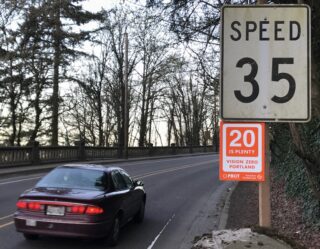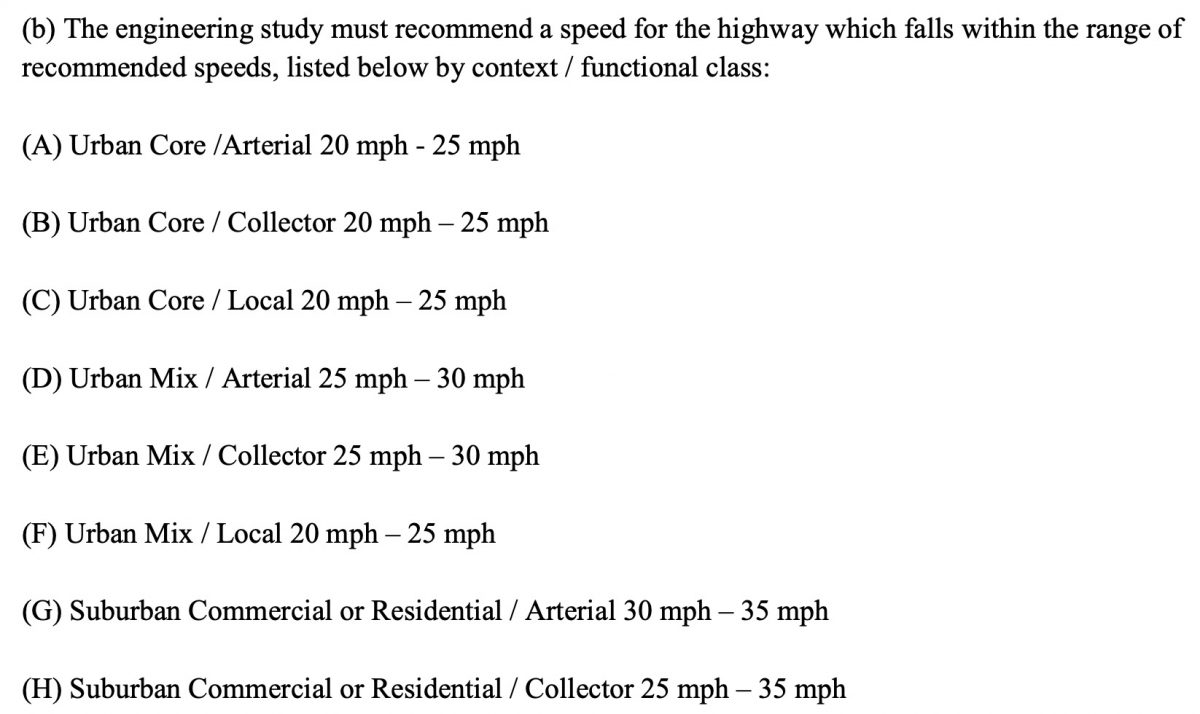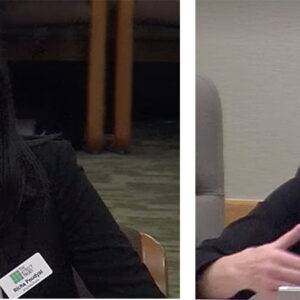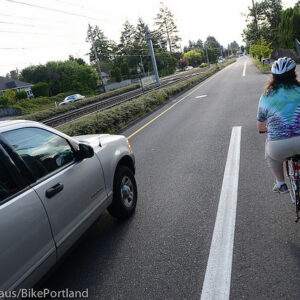 On May 1st, traffic engineers in the state of Oregon will no longer rely on an outdated and dangerous method for setting speed limits. Thanks to new rules adopted by the Oregon Transportation Commission last month, the process for for designating speeds has changed dramatically and now goes way beyond the traditional 85 percentile method.
On May 1st, traffic engineers in the state of Oregon will no longer rely on an outdated and dangerous method for setting speed limits. Thanks to new rules adopted by the Oregon Transportation Commission last month, the process for for designating speeds has changed dramatically and now goes way beyond the traditional 85 percentile method.
The 85th percentile rule has dominated U.S. traffic engineering since it was championed in the 1960s. It says limits should set at the speed which 85% of drivers are currently driving at or under. What could possibly go wrong? Since it’s a universal phenomenon that people drive faster than what’s safe, this methodology is very biased toward higher speeds and it’s a big factor in America’s rising traffic death toll.
Thankfully it has fallen out of favor and Oregon has taken a big step toward modernizing its approach. The new rule (which applies to all public roads except interstate freeways), adds many new factors into the decision-making process. When setting speeds, engineers will now have statutory guidance to consider things like: dense urban contexts, presence of foot and bicycle traffic, demographics of road users, crash rate, public input, and other new factors.
The adopted rule also introduces a fiftieth percentile rule along with new functional street classifications such as “urban mix”, “urban core”, and “suburban fringe” that allow engineers to further tune their analysis. It has also codified a list of recommend speeds for those new classifications (see graphic below).
Advertisement
In short, the new rule gives city traffic engineers powerful new options when making a request to ODOT for a different speed limit.
This change comes as the result of growing national awareness of the failings of the 85 percentile rule and amid an alarming rise in traffic fatalities where speed was a major factor.
The City of Portland was instrumental in lobbying for this change. Portland Bureau of Transportation hasn’t used the 85th percentile rule for many years and has spent years urging ODOT to change its speed setting methodology.
Reached for comment about the new rule, ODOT Deputy Director Travis Brouwer said they are in the process of filing them with the Secretary of State with a requested effective date of May 1st. “That slight lag in implementation from OTC approval will give us a chance to get guidance out to investigators and traffic engineers about the new process,” Brouwer said.
It can’t happen soon enough.
If you’re a safe streets activist, add this powerful new tool to your arsenal. See the full text of the new rule here. And here’s a PDF showing the changes between the new rule and the old one.
— Jonathan Maus: (503) 706-8804, @jonathan_maus on Twitter and jonathan@bikeportland.org
— Get our headlines delivered to your inbox.
— Support this independent community media outlet with a one-time contribution or monthly subscription.








Thanks for reading.
BikePortland has served this community with independent community journalism since 2005. We rely on subscriptions from readers like you to survive. Your financial support is vital in keeping this valuable resource alive and well.
Please subscribe today to strengthen and expand our work.
That’s actually fairly amazing they’re doing this. 85th percentile speed has been around so long, you could almost see it taking on the same air of inevitability as anything else that’s been around since before you were born. You’ve probably never been in a world that doesn’t have this idea in it. Unless you remember a world where the Beatles are on tour, the Stones are still nobodies, and JFK is alive. Frickin weird to think about.
Yes this is a big step forward. (The 85 Percentile Rule could have been more fairly used / balanced way if traffic engineers had allowed it to be used to also set the floor of congested urban arterials below 25 mph or factor in traffic calming devices….but no it was typically used to “trend up” arterial speeds. )
I am surprised the OTC did not allow a lower than 20 mph speed threshold…say 15 mph at least or develop a special pedestrian centric facility (winkel: a commercial woonerf). I hope the OTC allowed lower school zone speed limits to 15 mph or 10 mph vs. leaving it at 20 mph.
I was also surprised there was nothing lower than 20 MPH. There are several very busy entertainment areas in the city where it’s not safe to go over 15 MPH due to all the illegally parked cars ruining sight lines to people trying to cross the road.
Plenty of narrow residential streets where even 15mph is pushing it.
But in practice, I find that people tend to drive slowly on these anyway despite higher limits. I suspect the people who don’t drive more slowly wouldn’t be dissuaded anyway.
I would love to see school zone speed limits lowered to 10 or 15 mph and all thru traffic and parents dropping off kids prohibited within 2 blocks of schools.
Would love to see more woonerfs in entertainment districts, nw 10th-13th avenues and similar.
AND
…And I surprised the OTC is still using an “outdated” term of “highway” to encompass all roadway facilities. At face value – his categorically biased term programs a design / management outcome of speed over other benefits and motorized vehicle priority over other users/ uses. ” For example from NYDOT, “The AASHTO “Green Book” (13) defines freeways as “arterial highways with full control of access. They are intended to provide for high levels of safety and efficiency in the movement of large volumes of traffic at high speeds.”
Better would have been the nuanced addition of “STREET OR ROAD”: “(b) The engineering study must recommend a speed for a highway, [STREET or ROAD] which falls…”
At best this might be “sloppy” [cut and paste job with missed words], even if this range of facilities are better defined elsewhere in the body document, we all know that too often engineers, engineering technicians and practitioners typically will only refer to (or reproduce) a specific table or figure without the enlightening details …
Jonathan (or BP readers) can you post a link to the full document?
IMO, a ‘road’ is a more generic term for any pathway connecting two distinct points, be it on land, along a river, or at sea – ‘Hampton Roads, VA’, ‘Leith Roads’ near Edinburgh Scotland, etc. A ‘street’ is specifically applied to roadways on land and has since Roman times usually been paved and lined with curbs and often gutters, even in rural areas. A ‘highway’ is just that, a ‘way’ or road, paved or unpaved, that is ‘high’ above the usually rural landscape, to allow wind to blow snow or other debris off the roadway surface, usually with drainage ditches on both sides.
Good news–may it start a national trend.
The speed limit means nothing here. People speed with impunity because there is no enforcement of the speed limit! It’s a free for all out there!
Absolutely meaningless change. Over here in Bend, many speed limits have been changed over the past few years, always lower. I ride, and occasionally drive on many of these roads. There is zero, I mean zero, change in drivers’ habits. They drive the speed that they always have, as long as they can get away with it. Which is forever. True story: yesterday, mid-morning, I walked past a parking lot of a closed business. There were three vehicles parked there, two motorcycle cops and one squad car. That is the sum total of traffic enforcement at any time of day in Bend. The three cops were standing, talking and joking, no masks, about 4′ away from each other. I had just run across Greenwood, speed limit 25, when a driver did not even slow down as he just missed me, going 40+ mph. This was about 30 seconds before I walked past the entire Bend Police Dept. traffic enforcement team. The Police Dept, at least in Bend, does not take speed limit enforcement even remotely seriously.
Followup. I e-mailed the Chief of Police about this and got a reply from a Captain. His explanation was that the cops were waiting to escort Meals on Wheels drivers. He also seemed to take seriously my comments about lack of social distancing. Disregarding the prioritization of Meal on Wheels over traffic enforcement aside, I appreciate getting a response from a relatively highly ranked officer.
Meals On Wheels is a great service, but why would they need a police escort?
Because they don’t trust the meals to not try to escape because some of the meals just recently spent time in the cooler?
I assume it was PR stunt for the police department. There is a ton of that kind of stuff now, feel-good moments made for TV. ‘We’re all in this together’ stuff.
Enforcement by police=inconsistent, sporadic, biased, expensive and inadequate to change drivers’ behaviors. Engineering is expensive, but usually designed to speed up traffic. Education is effective only with ongoing varieties of messages from many sources.
The flaws of the 85th percentile rule are so obvious, it’s scary that it ever got put into place.
= Car Head.
Not bad! Hopefully next is mobile speed cameras with randomized changing locations.
Credit were credit is due. This change was encouraged by PBOT, but ODOT did the heavy lifting crafting the rules based on pending research at the national level.
https://apps.trb.org/cmsfeed/TRBNetProjectDisplay.asp?ProjectID=4052
PBOT has been frequently surprised of late by ODOT as well.
Are we talking about setting speed limit here or determining design speed. I am not aware that traffic engineers typically set speed limits. Is that the case in Oregon? If not are talking about the procedure for setting design speed – that would be a different story all-to-gather but nonetheless quite an important change in practice and mind set. I would love to see a clarification of which of these issues this story is about. Both?
This new procedure is for non-statutory posted speed limits, not design speed.
That seems like an important issue. Say a new road is being designed, or changes are being made to an existing one. With this new rule, perhaps the speed limit will be able to be set at say, 25 or 30 mph instead of 35. But will the road still be designed for 35 mph traffic?